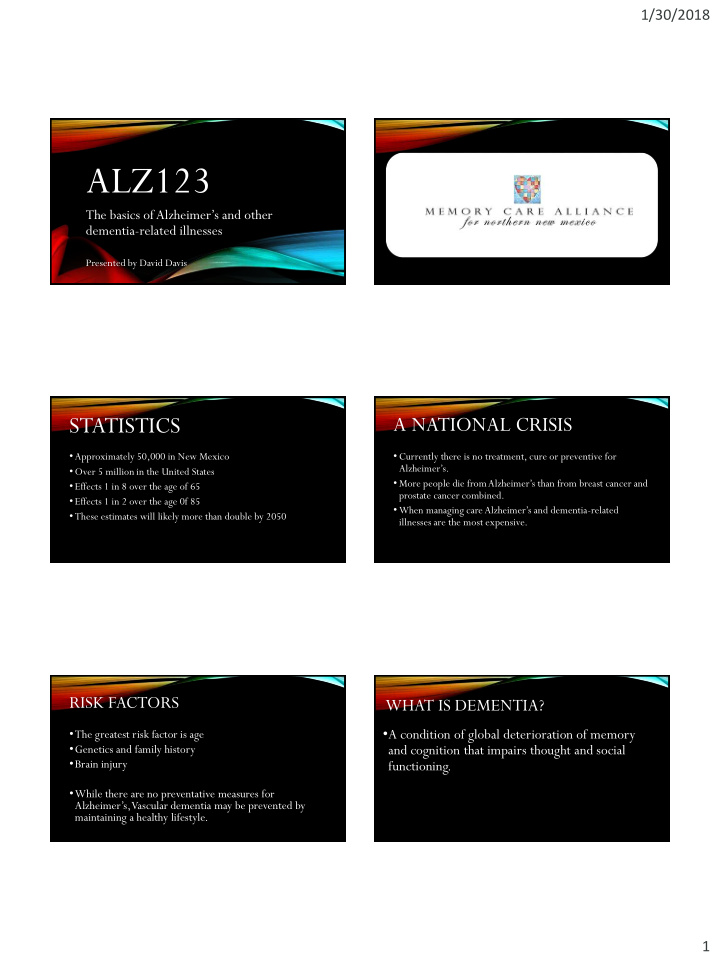



1/30/2018 ALZ123 The basics of Alzheimer’s and other dementia-related illnesses Presented by David Davis STATISTICS A NATIONAL CRISIS • Approximately 50,000 in New Mexico • Currently there is no treatment, cure or preventive for Alzheimer’s. • Over 5 million in the United States • More people die from Alzheimer’s than from breast cancer and • Effects 1 in 8 over the age of 65 prostate cancer combined. • Effects 1 in 2 over the age 0f 85 • When managing care Alzheimer’s and dementia -related • These estimates will likely more than double by 2050 illnesses are the most expensive. RISK FACTORS WHAT IS DEMENTIA? • A condition of global deterioration of memory • The greatest risk factor is age • Genetics and family history and cognition that impairs thought and social • Brain injury functioning. • While there are no preventative measures for Alzheimer’s, Vascular dementia may be prevented by maintaining a healthy lifestyle. 1
1/30/2018 TYPES OF DEMENTIA WHAT IT IS NOT • It is not a normal part of aging Alzheimer’s Vascular • It is not contagious Lewy Body • It not hereditary Parkinson’s related • Anything intentional on the part of the patient Head trauma or injury All of these types of dementia’s are considered to non -reversible. Some types of dementia, however, are reversible. SYMTOMS DIAGNOSIS • Why is it important? What to look for Can often go un-noticed for years • Why is an early diagnosis even more Who will make observations? important? Say something THE DIAGNOSTIC PROCESS MEDICATIONS • Visit with primary care physician. • Aricept, generic Donezipril • Basic general interview with patient and hopefully a family • Namenda member. • Exelon • Cognitive test. • Basic neurological test. • CT scan or MRI • Spinal tap • Time 2
1/30/2018 3
1/30/2018 EXPERIMENTAL DRUG TRIALS IN MULTICENTER VASCULAR DEMENTIA STUDY: BIOMARKERS IN VCID (MARKVCID) ALZHEIMER’S DISEASE AT UNM UNM has been selected as one of 7 Nicotine patch for improvement of memory function. centers around the country to develop A two-year double blind study to test the benefit of nicotine. biomarkers for the diagnosis of vascular cognitive impairment. Patients with cognitive complaints Amyloid antibody to remove amyloid plaques. and/or white matter injury on MRI are The antibody is given by iv infusion each month. recruited for this 5-year study. Improvement in thinking and removal of amyloid are tested. MARKVCID STUDY TESTING GOALS FOR MARKVCID NIH established a 7 center consortium to study the vascular impact on • Biomarkers are collected at entry into the study that can Alzheimer’s disease. be used to predict future diagnoses. • Patients undergo a clinical and neuropsychological In the first two years each center will test examination, a research MRI, and a lumbar puncture for the biomarkers they proposed. CSF. • The goal is to identify patients with inflammation that In the third and fourth years we test have a progressive course. each others biomarkers. • This is the optimal group for treatment trials once a treatment to control inflammation is found. In the fifth year we use the biomarkers to test new treatments. 4
1/30/2018 UNM MAC Clinical And Research Team RESEARCH COORDINATOR UNM Clinical Group Jillian Prestopnik, PhD • ERIKA PARTRIDGE John Adair, MD • Janice Knoefel, MD • 505-272-7456 • Jeffrey Thompson, BS UNM NMR and MRN EPARTRIDGE@SALUD.UNM.EDU Imaging Group • Arvind Caprihan, PhD • Vince Calhoun, PhD Biostatistician Erik Erhardt • FOR MORE INFORMATION ABOUT: THE MEMORY CARE ALLIANCE THE MEMORY AND AGING CENTER AT UNM ALZHEIMER’S DISEASE DAVID DAVIS DDALZNM@GMAIL.COM 5
Recommend
More recommend